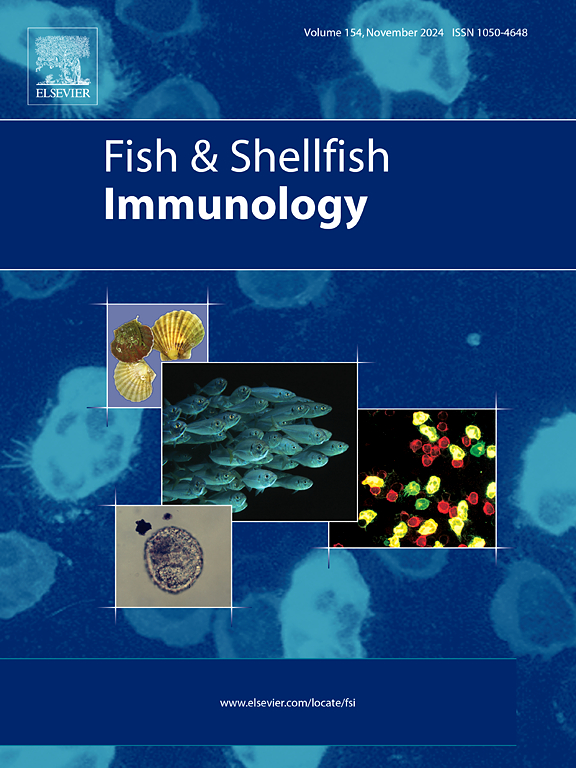Comparative analysis of the stress and immune responses in Atlantic salmon (Salmo salar) inoculated with live and inactivated Piscirickettsia salmonis
IF 4.1
2区 农林科学
Q1 FISHERIES
引用次数: 0
Abstract
Piscirickettsiosis causes the highest mortality in Atlantic salmon (Salmo salar) farming, and prophylactic treatment has not provided complete protection to date. In this study, we analyzed the immune and metabolic responses of Atlantic salmon inoculated with live and inactivated Piscirickettsia salmonis, monitoring plasma markers related to immune and stress responses. The fish were inoculated with inactivated P. salmonis, live P. salmonis, and culture medium (as control group). Blood and head-kidney samples were collected on days 3, 7, and 14 post-inoculations (dpi). Glucose and lactate levels did not show statistical differences, while cortisol levels increased from day 3 to day 14 in fish inoculated with live P. salmonis and only at 7 dpi in those inoculated with inactivated P. salmonis. Furthermore, anti-P. salmonis IgM-type immunoglobulins increased up to 14 dpi in fish inoculated with live P. salmonis but showed no change in those inoculated with inactivated P. salmonis. Meanwhile, immune markers involved in type I responses (tnfα-1, ifnγ, and cd8β) and regulatory responses (il10, tgfβ-1, and cd4-1) displayed differences between fish inoculated with live and inactivated P. salmonis. In fish inoculated with live P. salmonis, there was a clear pattern of increase at both 3 and 14 dpi, while those inoculated with inactivated P. salmonis showed a greater increase at 3 dpi. Our findings suggest that the nature of antigen may influence humoral immunity (anti-P. salmonis IgM) and the gene expression of markers involved in type I and regulatory immune responses in Atlantic salmon.
大西洋鲑鱼(Salmo salar)接种活的和灭活的piscirickettssia沙门氏菌后应激和免疫反应的比较分析。
pisciricketsiosis在大西洋鲑鱼养殖中造成的死亡率最高,迄今为止预防性治疗尚未提供完全保护。在这项研究中,我们分析了接种活的和灭活的大西洋鲑鱼的免疫和代谢反应,监测了与免疫和应激反应相关的血浆标志物。分别接种灭活沙门氏菌、活沙门氏菌和培养基作为对照组。接种后第3、7、14天采集血液和头肾标本。葡萄糖和乳酸水平没有统计学差异,而皮质醇水平在接种活沙门氏菌的鱼中从第3天到第14天增加,而在接种灭活沙门氏菌的鱼中仅在第7天增加。此外,anti-P。接种活沙门氏菌后,igm型免疫球蛋白升高高达14 dpi,而接种灭活沙门氏菌后,igm型免疫球蛋白没有变化。同时,参与I型反应的免疫标记(tnfα-1、ifnγ和cd8β)和调节反应(il10、tgfβ-1和cd4-1)在接种活沙门氏菌和灭活沙门氏菌的鱼之间显示出差异。在接种活沙门氏菌的鱼中,在3和14 dpi时均有明显的增加,而接种灭活沙门氏菌的鱼在3 dpi时增幅更大。我们的发现提示抗原的性质可能影响体液免疫(抗p。大西洋鲑鱼IgM)和参与I型和调节性免疫反应的标记基因表达。
本文章由计算机程序翻译,如有差异,请以英文原文为准。
求助全文
约1分钟内获得全文
求助全文
来源期刊

Fish & shellfish immunology
农林科学-海洋与淡水生物学
CiteScore
7.50
自引率
19.10%
发文量
750
审稿时长
68 days
期刊介绍:
Fish and Shellfish Immunology rapidly publishes high-quality, peer-refereed contributions in the expanding fields of fish and shellfish immunology. It presents studies on the basic mechanisms of both the specific and non-specific defense systems, the cells, tissues, and humoral factors involved, their dependence on environmental and intrinsic factors, response to pathogens, response to vaccination, and applied studies on the development of specific vaccines for use in the aquaculture industry.
 求助内容:
求助内容: 应助结果提醒方式:
应助结果提醒方式:


